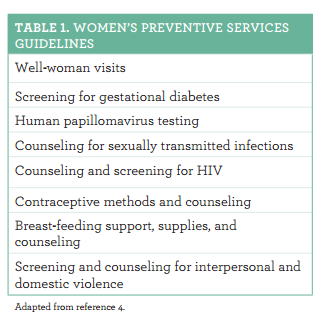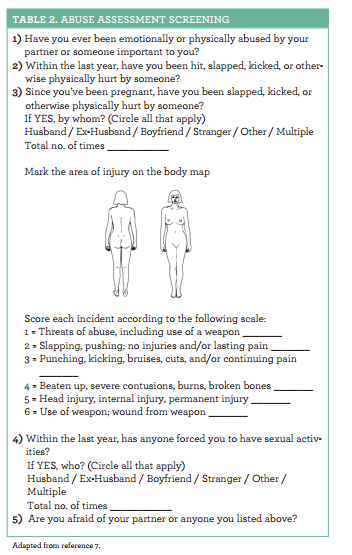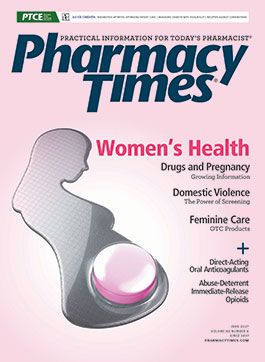Publication
Article
Pharmacy Times
Domestic Violence: The Power of Screening
Author(s):
Screening is considered the most effective method of preventing and reducing the impact of domestic violence.
Screening is considered the most effective method of preventing and reducing the impact of domestic violence. Pharmacists have a unique opportunity to assess for, and intervene in, these situations.1 Identifying and referring patients who have been exposed to domestic violence can prevent additional physical injuries and lead to a positive impact on their mental and physical health.2
Community pharmacists are considered the most accessible members of the health care team. Extending screening for domestic violence at the community pharmacy level may have an important and positive impact on domestic violence.2
According to the 2010 National Intimate Partner and Sexual Violence Survey, published in a report by the CDC, domestic violence, or intimate partner violence, affects more than 12 million individuals in the United States each year. The CDC reported that more than 35% of women and more than 28% of men are, at some point, physically assaulted, sexually assaulted, or stalked by an intimate partner.2
EVIDENCE OF CONCERN
Those exposed to domestic violence experience worsening of chronic conditions, which is often due to poor health behaviors and stress. They also tend to report pain more often and use pain medications more than those not exposed to domestic violence.2
The impact of domestic violence does not stop with the immediate victim; it extends to the children of parents exposed to domestic violence. In addition, according to the CDC, domestic violence costs $8.3 billion in health care utilization each year, as of 2003.2

RECENT EFFORTS
In 2011, the US Department of Health and Human Services (HHS) adopted recommendations released by the Institute of Medicine (now known as the National Academy of Sciences) on preventive services that focus on filling gaps in existing guidelines for women to help ensure their health and well-being. These recommendations identified 8 key preventive services.3,4 The Women’s Preventive Services Guidelines ensure women can receive a comprehensive set of recommended preventive health services without having a co-pay, coinsurance, or a deductible. These preventive health services include screening and counseling for interpersonal and domestic violence (Table 14 ).3-5
The Affordable Care Act presently requires many health plans to provide coverage for certain preventive health services, including screening and counseling for interpersonal and domestic violence. In addition, in January 2013, the US Preventive Services Task Force released a recommendation that calls for clinicians to “screen women of childbearing age for intimate partner violence.”3
THE PHARMACIST’S ROLE
Pharmacists do not need to be experts in interpersonal and domestic violence to conduct a screening. If a woman discloses that she has been abused, the pharmacist can provide brief counseling to promote the patient’s safety, discuss the possible relationship between interpersonal and domestic violence and the patient’s health concerns, and refer the patient to domestic violence programs, resources, and services.5
However, certain states have mandatory laws for reporting interpersonal and domestic violence. Because each state’s laws vary and patients’ assessments of their own safety take precedence, it is critical to discuss any confidentiality concerns with patients. It is also important to note that victims may be hesitant to disclose abuse out of fear, as the situation could be reported to police or child protective services.5
For additional information on your state laws, refer to Family Violence Prevention & Services at HHS’s website at acf.hhs.gov/ fysb/programs/family-violence-prevention-services.5
INDICATORS OF ABUSE
The following are indicators that may help to identify a patient who is exposed to domestic violence1 :
• Unexplained or multiple injuries, such as burns, bruises, lacerations, and bites
• Injuries at different stages of healing
• Injuries hidden by clothing or on central body areas
• A delay between an injury and when the patient seeks care
• Describes himself or herself as “accident-prone”
• Partner is present at health care provider visits and/or speaks for the patient
• Appears to have low self-esteem • History of alcohol or drug abuse
• History of depression, anxiety, or suicide attempts
• Continues to be seen for somatic complaints, such as headaches, pelvic pain, and gastric upset
DISCLOSING ABUSE
It is common for many health care providers not to know how to handle the situation when a patient discloses interpersonal and domestic violence, in addition to not being sure how to provide counseling. This is okay. Therefore, it is a good idea for health care providers to determine local resources and make contact with these support services ahead of time to be prepared in case they encounter an abuse victim in the practice setting. This way, when and if abuse is disclosed, the health care provider can give referrals and information and allow patients to make the best decision for themselves.5

SCREENING FOR DOMESTIC VIOLENCE
When screening, consider asking a few brief, open-ended questions. To facilitate this process, you can utilize brochures, forms, or other assessment tools. The CDC has compiled various resources for assessing domestic violence and sexual violence victimization, which can be found by visiting cdc.gov/violenceprevention/pdf/ ipv/ipvandsvscreening.pdf. One option is a 5-question Abuse Assessment Screening tool (Table 27 ).6,7
RESOURCES FOR PATIENTS
For more information about screening and counseling for interpersonal and domestic violence, the following resources are available5 :
- National Domestic Violence Hotline: 800-799-SAFE (7233) or TTY 800-787-3224 thehotline.org
- National Dating Abuse Helpline: 866-331-9474 or TTY 866-331-8453 loveisrespect.org (live chat is available) Text “loveis” to 77054
RESOURCES FOR HEALTH CARE PROVIDERS
To learn more about how pharmacists can respond to domestic violence, the HHS-funded Domestic Violence Resource Network (DVRN) can be found by visiting acf.hhs.gov/programs/fysb/programs/family-violence-prevention-services/programs/centers.
The National Health Resource Center on Domestic Violence (NHRCDV) is a great resource, too, and part of DVRN. The NHRCDV provides patient brochures, safety plans, training materials, and educational tools to help health care providers respond to interpersonal and domestic violence in health care settings.6 These resources can be found at acf.hhs.gov/fysb/programs/family-violence -prevention-services.5
Dr. Anyssa Garza received her doctor of pharmacy degree from the University of Texas at Austin before becoming the director of pharmacy for a Central Texas Department of Aging and Disability facility. She now serves as the vice president of content and patient education programs at RxWiki. In this role, she provides patients with medication information and medical knowledge that can contribute significantly to the quality of care they receive and improve their quality of life and health outcomes. Her work focuses on educating patients and providing them with the resources they need to navigate the health system and their health care issues. She also is an adjunct assistant professor at the University of Texas at Austin College of Pharmacy.
REFERENCES
- McClure BM. Domestic violence: the role of the health care professional. Mich Fam Rev. 1996;2(1):63-75.
- Barnard M, West-Strum D, Holmes E, Yang Y, Swain KA. Community pharmacists’ awareness of intimate partner violence: an exploratory study. Innovations in Pharmacy/University of Minnesota website. pubs.lib.umn.edu/innovations/vol4/iss1/7/. Accessed May 5, 2017.
- Screening for domestic violence in health care settings. Office of the Assistant Secretary for Planning and Evaluation website. aspe.hhs.gov/report/screening-domestic-violence-health-care-settings. Published August 1, 2013. Accessed March 1, 2017.
- Women’s preventive services guidelines. Health Resources & Services Administration website. hrsa.gov/womensguidelines/. Updated December 20, 2016. Accessed March 1, 2017.
- Screening and counseling fact sheet. Office on Women’s Health website. www.womenshealth.gov/publications/our-publications/fact-sheet/screening-counseling-fact-sheet.html. Updated October 25, 2013. Accessed March 1, 2017.
- The Center for Consumer Information & Insurance Oversight. Affordable Care Act implementation FAQs - set 12. CMS website. cms.gov/CCIIO/Resources/Fact-Sheets-and-FAQs/aca_implementation_faqs12.html#Coverage%20of%20Preventive%20Services. Accessed March 25, 2017.
- Basile KC, Hertz MF, Back SE. Intimate partner violence and sexual violence victimization assessment instruments for use in healthcare settings: Version 1. Atlanta, GA: Centers for Disease Control and Prevention, National Center for Injury Prevention and Control; 2007.







